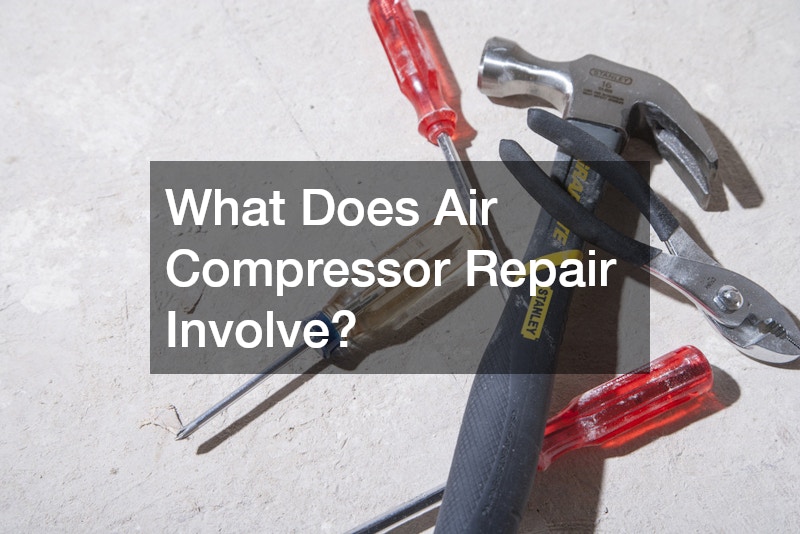Air compressors are essential tools used in various industries, from manufacturing and construction to healthcare and automotive applications. These machines play a critical role in powering pneumatic tools, machinery, and systems that require compressed air. However, like any mechanical equipment, air compressors are prone to wear and tear, and they may require repair over time. Knowing what air compressor repair involves can help you understand how to maintain your equipment, extend its lifespan, and address common issues when they arise.
Common Air Compressor Issues
Air compressors can face a variety of issues that hinder their performance, leading to inefficiencies, breakdowns, or even complete failure. Some of the most common problems that necessitate repair include:
Loss of Pressure: One of the most frequent issues with air compressors is a loss of pressure.
This can be caused by air leaks, clogged filters, or a malfunctioning pressure switch. Without sufficient pressure, the compressor cannot function efficiently, and it may struggle to operate pneumatic tools or machinery.
Overheating: Air compressors generate heat during operation, and if the cooling system is not functioning properly, the compressor may overheat. This can lead to damage to internal components, such as the motor or piston rings, and can cause the compressor to shut down.
Excessive Noise or Vibration: Air compressors should operate relatively quietly. If the compressor begins to produce unusual sounds, such as banging, grinding, or loud vibrations, it may indicate an issue with the motor, belts, or internal components. Such noises should be addressed immediately to prevent further damage.
Oil Leaks: Many air compressors, particularly oil-lubricated models, rely on oil to keep internal parts running smoothly. If oil begins to leak from the compressor, it can lead to a decrease in lubrication and cause internal parts to wear out prematurely.
Electrical Failures: Air compressors are powered by electric motors, and electrical failures can cause the compressor to stop working. Issues like a blown fuse, faulty wiring, or a malfunctioning motor control switch may require attention from a professional.
Dirty or Clogged Filters: Air filters are designed to keep contaminants like dust and debris from entering the compressor’s internal components. Over time, these filters can become clogged with dirt, reducing airflow and causing the compressor to work harder. This can lead to overheating, loss of efficiency, and potential damage.
Steps Involved in Air Compressor Repair
Repairing an air compressor involves a series of steps aimed at identifying and addressing the underlying issue. Here’s a general overview of the repair process:
1. Diagnosing the Problem
The first step in any repair is diagnosing the problem. Technicians will begin by inspecting the compressor to identify any obvious signs of wear or damage. They may also run tests to check the functionality of the motor, pressure switch, or other components. The technician will listen for unusual noises, check for leaks, and measure the pressure levels to determine the source of the problem.
Some common diagnostic tools used in air compressor repair include:
Pressure gauges to check for correct operating pressure.
Multimeters to test electrical components.
Leak detectors to find air leaks in the system.
Thermometers to monitor temperature and detect overheating issues.
2. Powering Down the Compressor
Before any repair work begins, safety is paramount. The compressor must be powered down and disconnected from its power source to avoid electrical shocks or accidental activation during the repair process. The technician will also relieve any pressure from the tank to prevent accidental releases of compressed air.
3. Cleaning and Replacing Filters
Dirty or clogged filters are a common cause of compressor inefficiency. A technician will often start by cleaning or replacing the air and oil filters, as this can significantly improve the performance of the compressor. Air filters are usually easy to remove and clean, but if they are too damaged, they may need to be replaced entirely.
4. Checking and Replacing Oil
If the compressor uses oil for lubrication, the technician will check the oil levels and quality. Low or contaminated oil can lead to friction and overheating, which may cause long-term damage to the compressor. In many cases, the technician will drain the old oil, replace it with fresh, high-quality oil, and ensure the oil filter is clean.
5. Inspecting and Replacing Seals and Gaskets
Seals and gaskets are crucial components that help prevent air and oil leaks. Over time, these parts can deteriorate due to wear, heat, or pressure. The technician will inspect the seals and gaskets for any signs of damage or wear. If necessary, they will replace them to ensure the compressor maintains proper pressure and efficiency.
6. Repairing or Replacing the Pressure Switch
A malfunctioning pressure switch is another common issue in air compressors. The pressure switch regulates the on and off cycles of the compressor based on the desired pressure. If it is malfunctioning, the compressor may not turn on or off at the right times, or it may cause excessive cycling.
If the pressure switch is faulty, the technician will either repair or replace it. This may involve adjusting the settings or replacing the switch entirely, depending on the severity of the problem.
Watch the video above to learn more about air compressor repair service!
.


